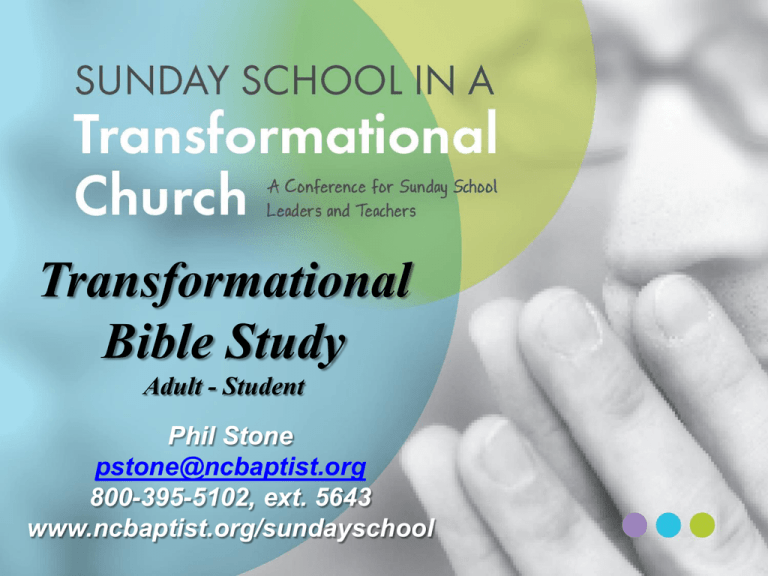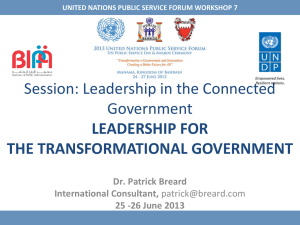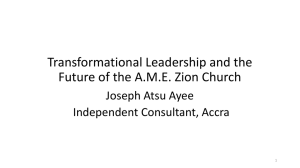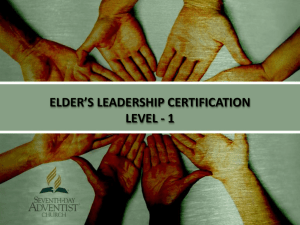PowerPoint - Leaderesource
advertisement

Transformational Bible Study Adult - Student Phil Stone pstone@ncbaptist.org 800-395-5102, ext. 5643 www.ncbaptist.org/sundayschool Transformation is Radical Change Discipleship is more than getting to know what the teacher knows; it's getting to be what s/he is. WTB - Wilkinson Challenge: If we invite people to “Come Learn with Us!” We need to make Bible study a transformational experience by teaching them the way they learn. Learning Is... Learning is Experiencing through discovery Teaching is Coaching the Experience A Teacher is a Coach of Experiences Therefore A teacher’s task is to set up experiences so that the learner can discover for himself Bible truths that are transformational. How People Learn... Five Senses: touch, smell, hear, sight, taste 1% 1½% 3½% 11% 83% Taste Touch Smell Hear Sight Support all verbal methods with a visual method! Teaching is more than telling; Learning is more than listening Methods: See Only…Hear and Tell Back… Read Only… See and Hear… Hear Only… Tell Back and Demonstrate… 10% 20% 30% 50% 70% 90% Read only Hear Only See Only See and Hear Hear and Tell Back Tell Back and Demonstrate Learners retain information better as direct involvement increases. The Power of Visuals When direct involvement of the learners is coupled with supportive visuals in the learning environment, retention increases from 3 days to 14 days! Bloom’s Taxonomy Evaluation Synthesis Analysis Application Comprehension Knowledge At what level does YOUR Bible study happen? Pedagogy • The art and science of childhood learning. Bible Story Children Concrete Facts Students Abstracts Transformational Biblical Truths Andragogy • The art and science of adult learning. Bible Passage Life Experiences Transformational Biblical Truths Three Learning Modes Use all three learning modes in every Bible Study. Auditory Learning - Hearing Visual Learning - Seeing Kinesthetic Learning - Doing Learning Styles Thinkers Rational, sequential, information centered Data collectors Unemotional Impatient with group discussion; wants to hear the leader Need opportunities to Hear something! Learning Styles Feelers Love to talk Generalize Loves small group discussions Listening and sharing ideas Needs opportunities to Talk! Learning Styles Sensors Loves hands on; doers Practical application Skip the theory, just do it Fast movers Action oriented Need opportunities to Do Something Learning Styles Intuitors Experimental attitudes Trial and Error Self-discovery Creativity Adaptable to other learning styles Need a process and reason for everything. We must shift from the traditional role of ‘knowledge dispenser’ to that of model, mentor, and organizer of experiences that help people grow. Lynn Stoddard, Redesigning Education. What are people looking for? Community …a safe place to belong Responsibility …hands-on ministry Connections …cross generational Depth …engaging Bible Study Definition: Depth is less about covering the content and more about engaging the content. Teaching with Depth Adults indicated that only 14 percent of a possible study time should be dedicated to teacher explanation or lecture as opposed to 40 percent for discussion and hands on learning. How did Jesus do it? Just then a religion scholar stood up with a question to test Jesus. “Teacher, what do I need to do to get eternal life?” Jesus answered, “What’s written in God’s Law? How do you interpret it?” How did Jesus do it? He said, “That you love the Lord your God with all your passion and prayer and muscle and intelligence – and that you love your neighbor as you do yourself” How did Jesus do it? “Good answer!” said Jesus. “Do it and you’ll live.” Looking for a loophole, he asked, “And just how would you define ‘neighbor’?” Jesus answered by telling a story…. (The Good Samaritan Parable) How did Jesus do it? “What do you think? Which of the three became a neighbor to the man attacked by robbers?” “The one who treated him kindly,” the religion scholar responded. Jesus said, “Go and do the same.” How did Jesus do it? Questions: With what did Jesus begin? Did Jesus “TELL” the scholar anything? Answers: …Jesus begins with the Word …Jesus let him discover the truth for himself …Then He said “go do it!” Knowledge is nothing without appropriation Transformational Philosophy of Bible Teaching When you begin to prepare a Bible study, what questions do you ask yourself? Philosophy helps you ask the right questions: How can learners …experience the biblical story? …discover for themselves the biblical truth? …get involved? A Transformational Philosophy… Where there is no involvement there is no learning! Gaines Dobbins Transformational Bible Study Principles Transformational Principle One: Coordination Start with a Team: Teacher - 1 per 25 adults - 1 per 12 students Care Group Leader - 1 per 4-6 members Outreach Leader Transformational Principle One: Coordination Coordinate Bible Study: Biblical Truth Teaching Aim Life Goal Life Impact Question Transformational Principle Two: Stimulation Stimulate or “hook learners’ attention” • Before Sunday - Session related contact • Outside the room - Session related visuals • Inside the room – Focal Wall Transformational Principle Two: Stimulation Stimulating Ideas: …Postcard or email about the lesson …Text members questions …Create a fb page …Twitter Transformational Principle Two: Stimulation Remember : …The room is the silent teacher …You can’t learn anything by looking at the back of somebody’s head! Transformational Principle Three: Motivation Motivate or “Jump starts learning” …Motivational activity …Biblical Truth …As the first learners enter the room. Transformational Principle Three: Motivation Motivating Ideas: … Pictures; Objects …Words; Questions …Activities; Displays …Characters Transformational Principle Four: Introduction Introduce the Unit …Use the Focal Wall …The “Big Idea” Session Titles and Biblical Truths Review Preview Focus …Read Biblical Truths aloud. OBEDIENT LOVE You can discover the best kind of love as you obey God. What Is True Love? COUNTERFIT LOVE Sexual sin leads to painful consequences Serving Love CONSTANT LOVE Dedicated service to God is a strong, fulfilling basis for a Christian marriage You can have a love that lasts. Sample Focal Wall Transformational Principle Five: Preparation Prepare learners with Background Information Preparation Ideas: Illustrated mini-lecture Monologues, skits, creative activities Read Bible passage and assign listening teams Time Out Announcements • Not first thing • Print • Bulletin board Prayer Request Share Briefly • Members • Ministry • Missional Keep it Word-Driven! Transformational Principle Six: Transition Transition back to Biblical Truth Transitional Ideas: …Re-Motivational Activity …Play game, e.g. - Agree/Disagree …Listen and Tell Back Questions Transformational Principle Seven: Examination Examine the Bible Passage …Involve Learners …Connect learners …Small Learning Teams …Written assignments …Questions; Creative methods Examination Ideas: Paper and Pencil Drama Art Games Verbal Music Technology Examination 5 Step Method’s Process Divide group into learning teams with written assignments: 1. Read in your Bible: (Provide Bibles) 2. Research: (Learner’s Guide) 3. Discover: (Questions) 4. Create: (Methods) 5. Practice and Present: (Peer Teaching) Depth is less about covering the content and more about engaging the content. Methods Approach Demonstrate and Tell Back 1. Read in your Bible. 2. Research – Learner or Leader Guide or commentary 3. Discover: a. What happened in the passage? b. What did it mean originally? c. What does it mean to you? 4. Create – Demonstration of Biblical truth - Methods 5. Present – Tell Back to the Group Team One • Read in your Bible: Mark 14:3-9 • Research: Hearing on page 42 of the Learner’s Guide • Discover: – – – – What happened in the story? What was significant about the woman’s actions? What was Jesus’ response? What can we learn about worship from this woman? • Create: Act out the Bible story to demonstrate Jesus’ response to the woman’s actions and to the onlookers. Option: Role play a person today expressing extravagant love to God. • Present: You have 15 minutes to create a 3 minute presentation. Transformational Principle Eight: Presentation Learning Teams Demonstrate and Tell Back to Group Biblical Truth Discovered: …Leader sits …Leader adds to - ties together Bible facts and truths …Leader facilitates discussion of relevance …Focus stays on Biblical Truth! “Where there is no involvement there is no learning.” Gains Dobbins Transformational Principle Nine: Application Applying the biblical truth …The Teaching Aim …General application: “What are some ways learners can apply this truth?” …Specific application: “What is one way you will apply this truth this week?” Transformational Principle Ten: Appropriation Appropriating truths into Life …Members …Ministry …Missional Appropriation Ideas: …Class Mission Projects …Outreach Fellowships …Family involvement “We’ve got to move from sitting in rows to sitting in circles to going out and changing the world.” Ed Stetzer Transformational Church Transformational Principles 1. Coordination 2. Stimulation 3. Motivation 4. Introduction 5. Preparation Time out : Announcements Prayer Requests 6. Transition 7. Examination 8. Presentation 9. Application 10.Appropriation Famous last words of a Transformational leader • I’m in no hurry. If you have questions “I’m in no hurry. If you have or just need to talk, questions or just need to talk, around. hang around!hang I’m available.” I’m available. Do your best to present yourself to God as one approved, a workman who does not need to be ashamed and who correctly handles the Word of Truth. 2 Timothy 2:15 (NIV) Making Disciples is worth all the effort! Phil Stone pstone@ncbaptist.org 800-395-5102, ext. 5643 www.ncbaptist.org/sundayschool • The second year of a 3 year focus on evangelism, discipleship, and mission involvement • An Intentional/Simple Discipleship Strategy • Easter Evangelism/Baptism Emphasis • 8 weeks of Sermon Outlines, Bible Studies, and Devotional Materials available online: www.finditherenc.org











